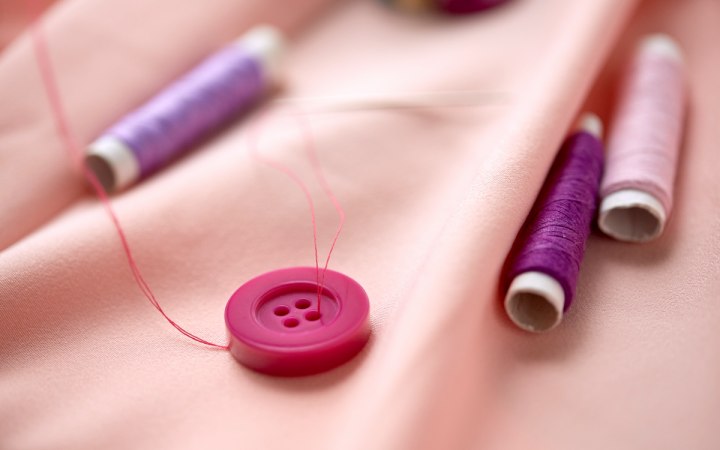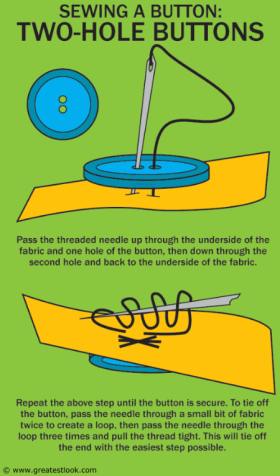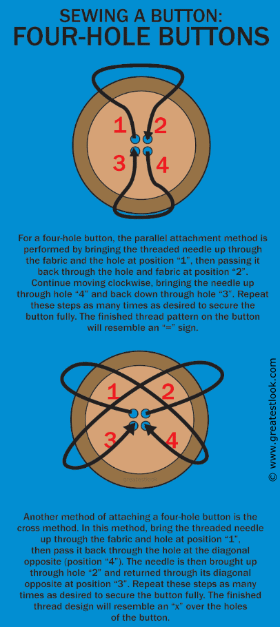How to Sew on a Button

Weíve all been there. We pull out that favorite shirt or blouse, or that seldom-worn suit and discover that just when you need it, thereís a button missing. You donít have time to take it to an alteration shop or the cleanerís for repairs, but you donít know how to fix it on your own. The truth of the matter is that most people in todayís age of instant gratification and disposable consumer goods have never learned the basic skills required to make even the simplest of garment repairs Ė i.e., sewing on a button.
I was fortunate in growing up in a small town with my mother and grandmother, because they both believed that there were certain things that every man needed to be able to do. (They didnít discriminate against young women. They just never imagined a world where a young woman might grow up NOT knowing these basics.) One of these things was sewing on a button. Now, I am here to share this knowledge with you.
• Needle
• Thread
• Button (either the one that came loose or a matching replacement)
• Scissors
To begin, thread your needle with thread that matches the color of the fabric of the garment (or matches the color of thread used to attach the other buttons on the garment). Next, take the garment with the missing button and find the location from which the button came. Pass the needle through the back side of the fabric but donít push it all the way through.
Slide the button onto the needle and hold it in place while you bring the needle through fully. How you proceed from here depends on the style and number of holes present in the button. Most buttons will be two-hole buttons, four-hole buttons, or stubbed buttons (having a stub on the back with a hole through the stub for attaching).
Stubbed buttons are easiest as they simply require passing the thread through the hole in the stub, back through the fabric and repeating these steps a few times then tying off the thread on the back side of the fabric.
Two-hole buttons are second easiest, as you simply pass the needle and thread through one hole then the other and back again until the button is secure, then tying off the thread on the back side of the fabric.

(Click to enlarge)
With four-hole buttons, you need to note how the other buttons are secured. This is usually done using a cross or parallel pattern. For the cross pattern, you simply pass the needle and thread up through one hole and down through the diagonal hole, then up through an adjacent hole and down through its diagonal opposite.

(Click to enlarge)
The parallel pattern is created by passing the needle and thread up through one hole, down through the next hole going clockwise, up through the next hole going clockwise and down through the last hole. These steps are repeated until the button is secured, then the thread is tied off on the back side of the fabric.
Finishing Steps:
If the button is for an outerwear garment, such as a top coat, you may want to give the button some slack in the thread and wind the thread around the underside of the button a few times before passing it through to the back side of the fabric for the final time for tying off. This will create a strong base for the button and protect the anchoring threads from wear and friction when the button is used.
In tying off the thread, here is a simple trick to make the tie-off simple and fast:
Once youíve passed the thread through to the back of the fabric for the tie-off, slip the needle through the back of the fabric in a shallow pass twice to form a loop. Next, pass the needle through the loop youíve created two or three times and pull tight. This will draw the loop to a close and create a secure knot at the same time. Afterward, you can simply snip the thread and youíre done.
{Tip: When sewing on a button, especially for hard-wearing clothing such as overcoats and work clothes, or for buttons that undergo a lot of stress, you may want to use a heavier gauge thread. The best recommendation I can make is to use quilting thread. These threads are generally woven from fibers, and also tend to be waxed to allow them to pass easily through heavier fabrics. Using quilting thread can make a big difference if you find that you tend to lose the same button frequently.}
© Greatestlook.com
Photo: Shutterstock
Related Posts:
How to clean silk
Caring for wool fabrics